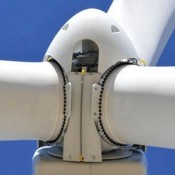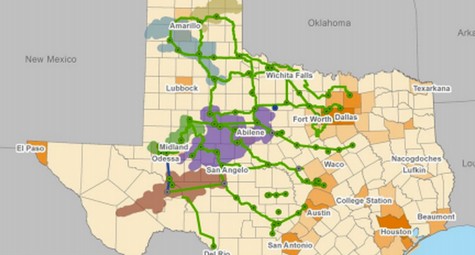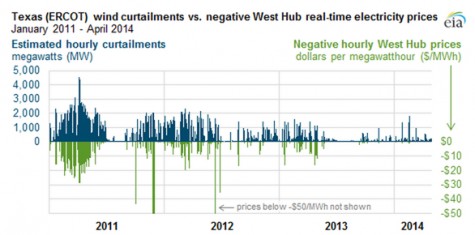At 8:48 pm on March 26, the amount wind power on the Texas grid climbed and then flew past an earlier record, topping out at 10,296 megawatts. Cranky coal executives probably grumbled, "It's an ill wind that blows, period." But it was no accident. Recently the US Energy Information Administration (EIA) released a report documenting that building new transmission lines across Texas - from the windy west to the power hungry east (I'm talking to you, Dallas) - has increased the amount of time wind farms, often throttled back by grid congestion, are able to transmit power.

Windy Amarillo
So if you want to see the results of an act of government so visionary that it would even make Ayn Rand weep as she clutched FDR's crutches like religious relics, you'd have to be willing to drive out to windy Amarillo, Texas, to watch construction crews putting up the last of 118 GE wind turbines that will send electricity to Houston this coming December.
This new wind farm, called the Grandview Phase I, is being built out in western Texas because it can feed unlimited power into 3,500 miles of hungry new transmission lines that connect rural areas, where you'll find the country's strongest winds, to the urban centers with a high demand for electricity. By encouraging wind farm development, the project, called the Competitive Renewable Energy Zones - shortened to CREZ - will eventually increase Texas wind capacity by 50%, three times more than any other state. Today, Texas has a bounty of 12,300 MW and over 8,000 MW in the pipeline.

Curtailed wind
Before these new transmission lines were up and running, over half of the state's wind turbines had been literally thrown up in just three years, between 2006-09, when 7,000 MW of wind capacity (about half of the state's current total) was added. Texas was sitting on an irritating and costly problem: whenever wind turbines in western Texas produced too much power, it caused congestion (or grid indigestion) over the old transmission lines.
As the problem grew, creating more and more frequent transmission burps, the grid's operator, the Electric Reliability Council of Texas (ERCOT) had to curtail (told to spin down) wind farms in order to keep the whole network working. A lot of potential power was wasted. In addition to the dead-in-the-water wind turbines, regional supply and demand imbalances caused wholesale electricity prices to frequently plunge and go negative.
In 2008, to unclog this bottleneck, the Public Utility Commission of Texas (PUCT) established five high wind "competitive renewable energy zones" (CREZ) and then cut a $7 billion check to build a series of transmission line expansions that would allow 18,500 MW of wind power to be transported to the rest of the state. As the report's chart shows, wind curtailments on the Texas electric grid have steadily dropped since 2011 as the 3,500 miles of transmission lines have been added and power flowed more freely.

The elimination of transmission constraints has helped wind generation in Texas reach new heights over the past year. At the same time as the new record for wind output was set in March, state wind generation was up 13% in 2013 over 2012. This rapid growth is a product of both the large number of new wind farms added during 2012 and also the reduction in wind curtailments.

At that record-breaking moment, wind supplied almost 29% of the state's total electricity load, with the average wind production 10,120 MW. This new record surpassed two highs reached during the previous week, while the record prior to March was 9,674 MW set in May 2013. It's now a good bet that March's wind power record will be trounced in the near future as the state continues to add more wind capacity.


